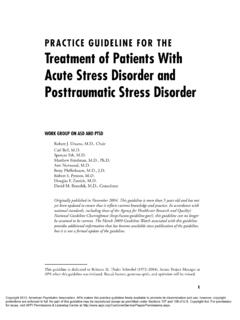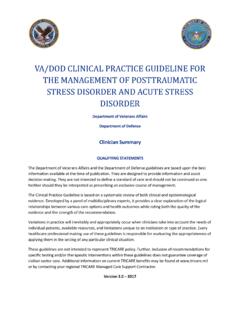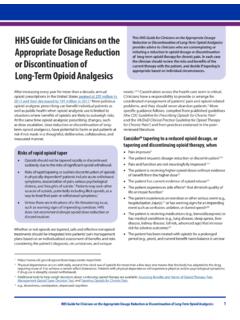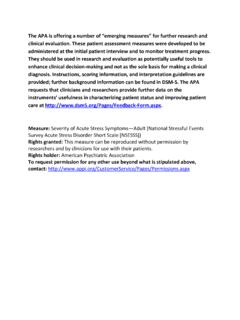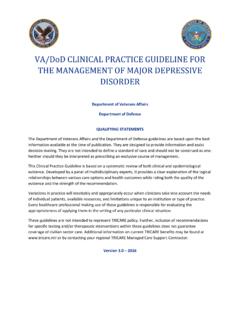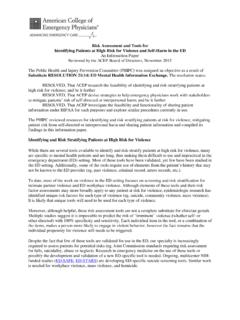Transcription of EXPOSURE TO STRESS - Centers for Disease Control and ...
1 EXPOSURE TO STRESSO ccupational Hazards in HospitalsDEPARTMENT OF HEALTH AND HUMAN SERVICES Centers for Disease Control and Prevention National Institute for Occupational Safety and HealthExposure to StressOccupational Hazards in HospitalsDEPARTMENT OF HEALTH AND HUMAN SERVICES Centers for Disease Control and Prevention National Institute for Occupational Safety and HealthiiThis document is in the public domain and may be freely copied or of any company or product does not constitute endorsement by the National Institute for Occupational Safety and Health (NIOSH).
2 In addition, citations to Web sites external to NIOSH do not constitute NIOSH endorsement of the sponsoring organizations or their programs or products. Furthermore, NIOSH is not re-sponsible for the content of these Web InformationTo receive documents or other information about occu-pational safety and health topics, contact NIOSH atTelephone: 1 800 CDC INFO (1 800 232 4636) TTY: 1 888 232 6348 E-mail: visit the NIOSH Web site at a monthly update on news at NIOSH, subscribe to NIOSH eNews by visiting (NIOSH) Publication No. 2008 136 July 2008 Safer Healthier PeopleTMiiiContentsIntroduction.
3 1 What causes occupational STRESS ? .. 1 What are the potential adverse health effects of occupational STRESS ?.. 3 How can STRESS be controlled in the workplace? .. 4 Case reports .. 9 More information about occupational STRESS .. 101 EXPOSURE to StressIntroductionOccupational STRESS has been a long-standing concern of the health care industry. Studies indicate that health care workers have higher rates of substance abuse and suicide than other professions and elevated rates of depression and anxiety linked to job STRESS . In addition to psychological distress, other outcomes of job STRESS include burnout, absenteeism, employee intent to leave, reduced patient satisfaction, and diagnosis and treat-ment purpose of this brochure is toidentify the sources of occupational STRESS , #identify the adverse health effects of occupational # STRESS , andrecommend work practices to reduce occupational # causes occupational STRESS ?
4 The National Institute for Occupational Safety and Health (NIOSH) defines occupational STRESS as the harmful physical and emotional responses that occur when the requirements of the job do not match the ca-pabilities, resources, or needs of the worker. The following workplace factors (job stressors) can re-sult in STRESS : Job or task demands (work overload, lack of task # Control , role ambiguity)2 Organizational factors (poor interpersonal rela- #tions, unfair management practices) Financial and economic factors #Conflict between work and family roles and re- #sponsibilitiesTraining and career development issues (lack of #opportunity for growth or promotion)Poor organizational climate (lack of management #commitment to core values, conflicting communi-cation styles, etc.)
5 Stressors common in health care settings include the following: Inadequate staffing levels #Long work hours #Shift work #Role ambiguity # EXPOSURE to infectious and hazardous substances #Stressors vary among health care occupations and even within occupations, depending on the task being per-formed. In general, studies of nurses have found the following factors to be linked with STRESS : Work overload #Time pressure #Lack of social support at work (especially from su- #pervisors, head nurses, and higher management) EXPOSURE to infectious diseases #Needlestick injuries # EXPOSURE to work-related violence or threats #Sleep deprivation #3 Role ambiguity and conflict #Understaffing #Career development issues #Dealing with difficult or seriously ill patients #Among physicians, the following factors are associated with STRESS .
6 Long hours #Excessive workload #Dealing with death and dying #Interpersonal conflicts with other staff #Patient expectations #Threat of malpractice litigation #The quality of patient care provided by a hospital may also affect health care worker STRESS . Beliefs about whether the institution provides high quality care may influence the perceived STRESS of job pressures and workload because higher quality care maybe reflected in greater support and availability of are the potential adverse health effects of occupational STRESS ? STRESS may be associated with the following types of re-actions:Psychological (irritability, job dissatisfaction, de- #pression)Behavioral (sleep problems, absenteeism) #Physical (headache, upset stomach, changes in #blood pressure) An acute traumatic event could cause post traumatic STRESS disorder (PTSD).
7 Not every traumatized person develops full-blown or even minor PTSD. 4 Although individual factors (such as coping strategies) and social resources can modify the reaction to occupa-tional stressors to some degree, working conditions can play a major role in placing workers at risk for develop-ing health can STRESS be controlled in the workplace? As a general rule, actions to reduce job STRESS should give top priority to organizational changes that improve working conditions. But even the most conscientious efforts to improve working conditions are unlikely to eliminate STRESS completely for all workers.
8 For this rea-son, a combination of organizational change and STRESS management is often the most successful approach for reducing STRESS at Change InterventionThe most effective way of reducing occupational STRESS is to eliminate the stressors by redesigning jobs or making organizational changes. Organizations should take the following measures:Ensure that the workload is in line with workers #capabilities and resourcesClearly define workers roles and responsibilities #Give workers opportunities to participate in deci- #sions and actions affecting their jobsImprove communication #Reduce uncertainty about career development and #future employment prospectsProvide opportunities for social interaction among #workers5 The most commonly implemented organizational inter-ventions in health care settings includeteam processes, #multidisciplinary health care teams.
9 And #multi-component interventions. #Team process or worker participatory methods give workers opportunities to participate in decisions and actions affecting their jobs. Workers receive clear infor-mation about their tasks and role in the department. Team-based approaches to redesign patient care delivery systems or to provide care ( , team nursing), have been successful in improving job satisfaction and reduc-ing turnover, absenteeism, and job health care teams ( , composed of doctors, nurses, managers, pharmacists, psychologists, etc.) have become increasingly common in acute , long-term, and primary care settings.
10 Teams can accomplish the following: Allow services to be delivered efficiently, without #sacrificing quality Save time (a team can perform activities concur- #rently that one worker would need to provide se-quentially)Promote innovation by exchanging ideas #Integrate and link information in ways that indi- #viduals cannotMulticomponent interventions are broad-based and may includerisk assessment, #intervention techniques, and #education. #6 Successful organizational STRESS interventions have sev-eral things in common: Involving workers at all stages of the intervention #Providing workers with the authority to develop, #implement, and evaluate the interventionSignificant commitment from top management #and buy-in from middle managementAn organizational culture that supports STRESS in- #terventionsPeriodic evaluations of the STRESS intervention #Without these components (in particular, manage-ment support) it is not likely that the intervention will succeed.










